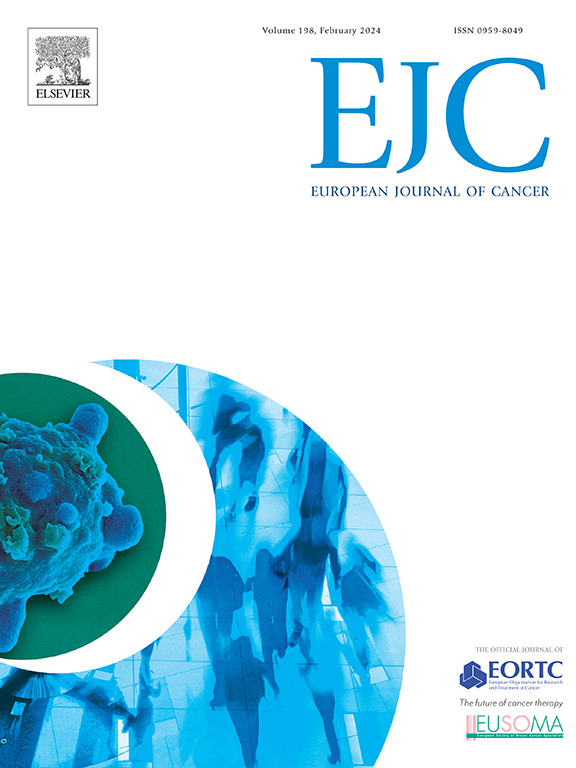Global disparities in artificial intelligence-based mammogram interpretation for breast cancer: A scientometric analysis of representation, trends, and equity
IF 7.6
1区 医学
Q1 ONCOLOGY
引用次数: 0
Abstract
Background
Breast cancer (BC) is the most frequently diagnosed cancer and the leading cause of cancer death among women worldwide. Artificial intelligence (AI) shows promise for improving mammogram interpretation, especially in resource-limited settings. However, concerns remain regarding the diversity of datasets and the representation of researchers in AI model development, which may affect the models’ generalizability, fairness, and equity.
Methods
We performed a scientometric analysis of studies published in 2017, 2018, 2022, and 2023 that used screening or diagnostic mammograms for BC detection to train or validate AI algorithms. PubMed (MEDLINE) and EMBASE were searched in July 2024. Data extraction focused on patient cohort sociodemographics (including age and race/ethnicity), geographic distribution (categorized by World Bank country income levels and regions), and author profiles (sex, affiliation, and funding sources).
Results
Of 5774 studies identified, 264 met the inclusion criteria. The number of studies increased from 28 in 2017-2018 to 115 in 2022-2023 - a 311% increase. Despite this growth, only 0–25 % of studies reported race/ethnicity, with most patients identified as Caucasian. Moreover, nearly all patient cohorts originated from high-income countries, with no studies from low-income settings. Author affiliations were predominantly from high-income regions, and gender imbalance was observed among first and last authors.
Conclusion
The lack of racial, ethnic, and geographic diversity in both datasets and researcher representation could undermine the generalizability and fairness of AI-based mammogram interpretation. Addressing these disparities through diverse dataset collection and inclusive international collaborations is critical to ensuring equitable improvements in breast cancer care.
基于人工智能的乳腺癌乳房x光检查解释的全球差异:代表性、趋势和公平性的科学计量学分析
乳腺癌(BC)是世界范围内最常见的癌症,也是女性癌症死亡的主要原因。人工智能(AI)有望改善乳房x光检查的解释,特别是在资源有限的情况下。然而,人工智能模型开发中数据集的多样性和研究人员的代表性仍然令人担忧,这可能会影响模型的普遍性、公平性和公平性。方法:我们对2017年、2018年、2022年和2023年发表的研究进行了科学计量学分析,这些研究使用筛查或诊断乳房x光检查来检测BC,以训练或验证人工智能算法。2024年7月检索PubMed (MEDLINE)和EMBASE。数据提取侧重于患者队列社会人口统计学(包括年龄和种族/民族)、地理分布(按世界银行国家收入水平和地区分类)和作者简介(性别、隶属关系和资金来源)。结果在纳入的5774项研究中,264项符合纳入标准。研究数量从2017-2018年的28项增加到2022-2023年的115项,增长了311%。尽管有这种增长,但只有0 - 25% %的研究报告了种族/民族,大多数患者被确定为白种人。此外,几乎所有患者队列都来自高收入国家,没有来自低收入国家的研究。作者主要来自高收入地区,第一作者和最后作者之间存在性别不平衡。结论数据集和研究人员代表性缺乏种族、民族和地理多样性可能会破坏基于人工智能的乳房x线照片解释的普遍性和公平性。通过多样化的数据集收集和包容性的国际合作来解决这些差异,对于确保公平改善乳腺癌护理至关重要。
本文章由计算机程序翻译,如有差异,请以英文原文为准。
求助全文
约1分钟内获得全文
求助全文
来源期刊

European Journal of Cancer
医学-肿瘤学
CiteScore
11.50
自引率
4.80%
发文量
953
审稿时长
23 days
期刊介绍:
The European Journal of Cancer (EJC) serves as a comprehensive platform integrating preclinical, digital, translational, and clinical research across the spectrum of cancer. From epidemiology, carcinogenesis, and biology to groundbreaking innovations in cancer treatment and patient care, the journal covers a wide array of topics. We publish original research, reviews, previews, editorial comments, and correspondence, fostering dialogue and advancement in the fight against cancer. Join us in our mission to drive progress and improve outcomes in cancer research and patient care.
 求助内容:
求助内容: 应助结果提醒方式:
应助结果提醒方式:


